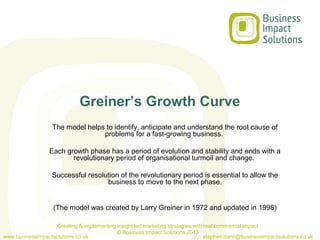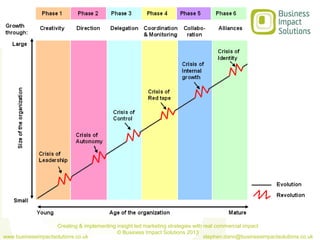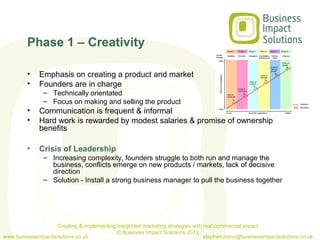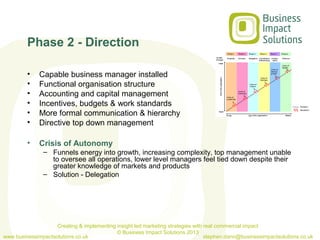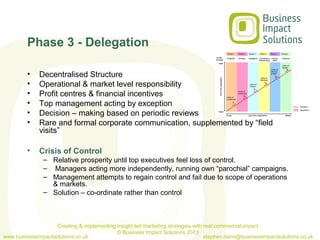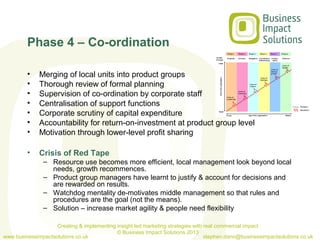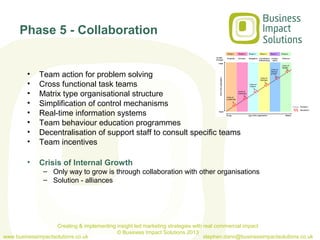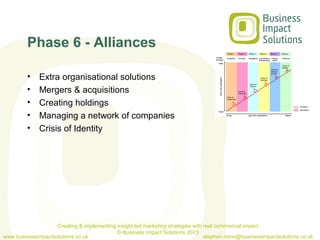Greiner’s Growth Curve
- 1. Greiner’s Growth Curve The model helps to identify, anticipate and understand the root cause of problems for a fast-growing business. Each growth phase has a period of evolution and stability and ends with a revolutionary period of organisational turmoil and change. Successful resolution of the revolutionary period is essential to allow the business to move to the next phase. (The model was created by Larry Greiner in 1972 and updated in 1998) Creating & implementing insight led marketing strategies with real commercial impact © Business Impact Solutions 2013 www.businessimpactsolutions.co.uk stephen.dann@businessimpactsolutions.co.uk
- 2. Creating & implementing insight led marketing strategies with real commercial impact © Business Impact Solutions 2013 www.businessimpactsolutions.co.uk stephen.dann@businessimpactsolutions.co.uk
- 3. Phase 1 – Creativity • Emphasis on creating a product and market • Founders are in charge – Technically orientated – Focus on making and selling the product • Communication is frequent & informal • Hard work is rewarded by modest salaries & promise of ownership benefits • Crisis of Leadership – Increasing complexity, founders struggle to both run and manage the business, conflicts emerge on new products / markets, lack of decisive direction – Solution - Install a strong business manager to pull the business together Creating & implementing insight led marketing strategies with real commercial impact © Business Impact Solutions 2013 www.businessimpactsolutions.co.uk stephen.dann@businessimpactsolutions.co.uk
- 4. Phase 2 - Direction • Capable business manager installed • Functional organisation structure • Accounting and capital management • Incentives, budgets & work standards • More formal communication & hierarchy • Directive top down management • Crisis of Autonomy – Funnels energy into growth, increasing complexity, top management unable to oversee all operations, lower level managers feel tied down despite their greater knowledge of markets and products – Solution - Delegation Creating & implementing insight led marketing strategies with real commercial impact © Business Impact Solutions 2013 www.businessimpactsolutions.co.uk stephen.dann@businessimpactsolutions.co.uk
- 5. Phase 3 - Delegation • Decentralised Structure • Operational & market level responsibility • Profit centres & financial incentives • Top management acting by exception • Decision – making based on periodic reviews • Rare and formal corporate communication, supplemented by “field visits” • Crisis of Control – Relative prosperity until top executives feel loss of control. – Managers acting more independently, running own “parochial” campaigns. – Management attempts to regain control and fail due to scope of operations & markets. – Solution – co-ordinate rather than control Creating & implementing insight led marketing strategies with real commercial impact © Business Impact Solutions 2013 www.businessimpactsolutions.co.uk stephen.dann@businessimpactsolutions.co.uk
- 6. Phase 4 – Co-ordination • Merging of local units into product groups • Thorough review of formal planning • Supervision of co-ordination by corporate staff • Centralisation of support functions • Corporate scrutiny of capital expenditure • Accountability for return-on-investment at product group level • Motivation through lower-level profit sharing • Crisis of Red Tape – Resource use becomes more efficient, local management look beyond local needs, growth recommences. – Product group managers have learnt to justify & account for decisions and are rewarded on results. – Watchdog mentality de-motivates middle management so that rules and procedures are the goal (not the means). – Solution – increase market agility & people need flexibility Creating & implementing insight led marketing strategies with real commercial impact © Business Impact Solutions 2013 www.businessimpactsolutions.co.uk stephen.dann@businessimpactsolutions.co.uk
- 7. Phase 5 - Collaboration • Team action for problem solving • Cross functional task teams • Matrix type organisational structure • Simplification of control mechanisms • Real-time information systems • Team behaviour education programmes • Decentralisation of support staff to consult specific teams • Team incentives • Crisis of Internal Growth – Only way to grow is through collaboration with other organisations – Solution - alliances Creating & implementing insight led marketing strategies with real commercial impact © Business Impact Solutions 2013 www.businessimpactsolutions.co.uk stephen.dann@businessimpactsolutions.co.uk
- 8. Phase 6 - Alliances • Extra organisational solutions • Mergers & acquisitions • Creating holdings • Managing a network of companies • Crisis of Identity Creating & implementing insight led marketing strategies with real commercial impact © Business Impact Solutions 2013 www.businessimpactsolutions.co.uk stephen.dann@businessimpactsolutions.co.uk
- 9. www.businessimpactsolutions.co.uk Blog: http://businessimpactsolutions.wordpress.com Creating & implementing insight led marketing strategies with real commercial impact © Business Impact Solutions 2013 www.businessimpactsolutions.co.uk stephen.dann@businessimpactsolutions.co.uk
- 10. www.businessimpactsolutions.co.uk Blog: http://businessimpactsolutions.wordpress.com Creating & implementing insight led marketing strategies with real commercial impact © Business Impact Solutions 2013 www.businessimpactsolutions.co.uk stephen.dann@businessimpactsolutions.co.uk

